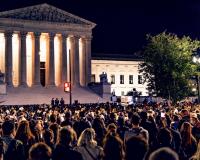
Vibrant Environment
Governance And Rule Of Law
All | Biodiversity | Climate Change and Sustainability | Environmental Justice | Governance and Rule of Law | Land Use and Natural Resources | Oceans and Coasts | Pollution Control

The biggest machine ever built is run by a consortium of European governments called CERN. Its Large Hadron Collider accelerates heavy subatomic particles at near light speed around a circle 17 miles in circumference before smashing them together. Scientists then study the remains and obtain important clues about how the universe works.

The COVID-19 pandemic has rendered profound changes to our everyday lives and economy that will have both immediate and long-term impacts on environmental law. In this month’s issue of ELR—The Environmental Law Reporter, Arden Rowell explores the implications of these changes for environmental law, and argues that grappling with them as the pandemic progresses may help lawmakers develop more effective strategies for environmental regulation.

The first session of the International Network for Environmental Compliance and Enforcement (INECE) six-part citizen science webinar series explored the current and potential uses of citizen/community science initiatives to improve environmental monitoring, compliance, and enforcement around the world. Citizen science encompasses a broad range of activities, ranging from the use of low-cost hand-held air monitors by individuals to sophisticated, university-based monitoring networks and satellite monitoring plans by large environmental NGOs. These activities can raise awareness of environmental issues, inform agency actions including compliance and enforcement programs, and inform citizen litigation to stop polluting activities.

The novel coronavirus has focused public attention on the indoor environment as never before. Even though most people in the United States spent the large majority of their time indoors before the pandemic, COVID-19 has increased awareness of the connection between indoor air quality and health. In addition to cleaning and disinfecting, technical topics such as building ventilation and filtration are now the subject of articles in popular media, not to mention conversations around the (virtual) water cooler and the school listserv.

In May 2016, EPA issued a lifetime Health Advisory (HA) of 70 parts per trillion (0.07 ug/L) for the combination of two per- and polyfluoroalkyl substances (PFAS) chemicals, PFOS and PFOA, in drinking water. EPA’s HA is not enforceable or regulatory—it provides technical information to state agencies and other public health officials on health effects, analytical methodologies, and treatment technologies associated with drinking water contamination. In EPA’s subsequent 2019 PFAS Action Plan, EPA noted that over 4,000 PFAS may have been manufactured and used in a variety of industries around the world since they were first synthesized in the 1940s. Because PFAS are water soluble, over time PFAS from firefighting foam, manufacturing sites, landfills, spills, air deposition from factories and other releases can seep into surface soils and potentially percolate into groundwater, thus implicating drinking water sources.

The untimely death of Justice Ruth Bader Ginsburg is a sharp setback for environmental protection law. The Court loses the justice who had been the most sympathetic to environmental concerns during her more than 27 years on the highest court of the land. Her greatest achievement on behalf of the environment was her majority opinion in 2000 in Friends of the Earth v. Laidlaw Environmental Services. This decision slammed the brakes on Justice Antonin Scalia’s long-time campaign to deny environmentalists standing to sue.

Environmental Protection Agency chief Andrew Wheeler proudly details the administration’s deregulatory record in a Newsweek opinion article published in late July. He frames his success story within President Trump’s January 2017 executive order requiring agencies to eliminate two regulations for each new one. While Wheeler touts the avoided costs, he doesn’t mention the avoided benefits the repealed rules would have provided.

It’s easy to grow numb in the face of the parade of problems our country has been experiencing, but news of the Trump Administration’s recent decision to defund diversity training across the federal government and to try to prevent federal contractors and grantees from engaging in such training jolted me with the force of a defibrillator. It is shocking that in the midst of a period of the worst racial unrest in many decades, this is what the Administration is bringing forward.

Acting in response to Executive Order No. 13807, Establishing Discipline and Accountability in the Environmental Review and Permitting Process for Infrastructure, the Council on Environmental Quality (CEQ) rewrote the governmentwide regulations implementing the National Environmental Policy Act (NEPA) this year. CEQ published its proposal to substantially amend the NEPA rule on January 10, 2020, and published its final rule on July 16, 2020 (85 Fed. Reg. 43304). The new rule becomes effective today, September 14, 2020, and CEQ added language to the final rule to provide that it will apply directly to federal agency actions and preempt all “inconsistent” agency procedures as of that date.

Almost one-quarter of all U.S. CO2 emissions come from fossil fuels extracted from public lands. Producing more than 274 million barrels of oil, 3.3 billion cubic feet of natural gas, and 302 million tons of coal each year, BLM’s management decisions have a significant impact on climate change. In this month’s issue of ELR—The Environmental Law Reporter, authors Jamie Gibbs Pleune, John Ruple, and Nada Wolff Culver argue that the Bureau has not only the authority, but a legal duty to mitigate climate change in its permitting decisions. Using existing legal structures, they provide a road map for requiring all new BLM oil and gas development to achieve net-zero emissions.